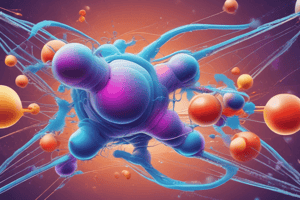Podcast
Questions and Answers
Solids, liquids, and gases have the same distances between particles.
Solids, liquids, and gases have the same distances between particles.
False (B)
An increase in temperature results in slower particle speed.
An increase in temperature results in slower particle speed.
False (B)
Intramolecular forces are weaker than intermolecular forces.
Intramolecular forces are weaker than intermolecular forces.
False (B)
Hydrogen bonding is an example of intramolecular forces.
Hydrogen bonding is an example of intramolecular forces.
London dispersion forces are also known as van der Waals forces.
London dispersion forces are also known as van der Waals forces.
Dipole-dipole forces exist between nonpolar molecules.
Dipole-dipole forces exist between nonpolar molecules.
Water is a colorless liquid at room temperature
Water is a colorless liquid at room temperature
Ice is denser than liquid water
Ice is denser than liquid water
Crystalline solids have a highly regular arrangement of particles
Crystalline solids have a highly regular arrangement of particles
Amorphous solids have a well-defined crystal lattice
Amorphous solids have a well-defined crystal lattice
The strength of intermolecular forces affects the Hvap of a substance
The strength of intermolecular forces affects the Hvap of a substance
Steam is the solid form of water at 100°C and 1 atm
Steam is the solid form of water at 100°C and 1 atm
Hydrogen bonding occurs between a hydrogen atom bound to a small non-metal and a highly electronegative element like Oxygen.
Hydrogen bonding occurs between a hydrogen atom bound to a small non-metal and a highly electronegative element like Oxygen.
Ion-dipole force explains the solubility of non-polar molecules in water.
Ion-dipole force explains the solubility of non-polar molecules in water.
London dispersion forces are the strongest type of intermolecular force.
London dispersion forces are the strongest type of intermolecular force.
Dipole-induced dipole forces occur between Polar and non-polar molecules.
Dipole-induced dipole forces occur between Polar and non-polar molecules.
Liquids have a defined structure that can be explained at the particulate level.
Liquids have a defined structure that can be explained at the particulate level.
Surface tension measures the amount of energy required to shrink the surface of a liquid by a unit area.
Surface tension measures the amount of energy required to shrink the surface of a liquid by a unit area.
Flashcards are hidden until you start studying
Study Notes
Hydrogen Bonding
- Hydrogen bonding is a special type of dipole-dipole force that exists between a hydrogen atom bound to a small and highly electronegative non-metal atom (e.g., Nitrogen, Fluorine, and Oxygen).
- Hydrogen bonding occurs in polar molecules containing H and highly electronegative elements.
Ion-Dipole Force
- Ion-dipole force acts between an ion (positive or negative) and a polar molecule.
- This explains the solubility of ionic compounds in water, which is a polar molecule.
- Ions and oppositely charged ends of water molecules overcome the attraction between ions themselves, causing each ion to separate and be surrounded by water molecules.
London Dispersion Forces
- London dispersion forces are the weakest type of intermolecular force.
- They occur when two non-polar molecules approach each other, forming an instantaneous dipole moment.
- This force is also known as induced dipole-induced dipole attraction.
Dipole-Induced Dipole Forces
- Dipole-induced dipole forces occur between polar and non-polar molecules.
Intermolecular Forces and Properties of Liquids
- Liquids do not have a structure, but many of their properties can be explained qualitatively by viewing them at the particulate level.
- Surface tension is the measure of the elastic force in the surface of a liquid.
- Surface tension is the amount of energy required to stretch or increase the surface of a liquid by a unit area.
Kinetic Molecular Theory
- The Kinetic Molecular Theory explains the properties of solids and liquids in terms of intermolecular forces of attraction and the kinetic energy of individual particles.
- All matter is made up of tiny particles in constant motion, with speed proportional to temperature.
- Increased temperature means greater speed.
Intermolecular Forces of Attraction
- Intermolecular forces of attraction are the attractive forces between molecules or particles in solid or liquid states.
- Intermolecular forces are relatively weaker than the forces within molecules (intramolecular forces).
- The intermolecular forces of attraction in a pure substance are collectively known as van der Waals forces.
Types of Intermolecular Forces
- Dipole-dipole forces exist between polar molecules.
- Hydrogen bonding is a special type of dipole-dipole force.
- Ion-dipole force acts between an ion and a polar molecule.
- London dispersion forces are the weakest type of intermolecular force.
- Dipole-induced dipole force occurs between polar and non-polar molecules.
Structure and Properties of Water
- Water is a good solvent with a high specific heat.
- Water has a high boiling point and a low density as a solid.
- Solid water is less dense than liquid water, causing ice to float on water.
Types and Properties of Solids
- Solids can be classified as crystalline or amorphous based on the arrangement of their particles.
- Crystalline solids have a highly regular arrangement of particles, while amorphous solids have considerable disorder in their structure.
- Amorphous solids, such as glass, are rapidly formed, preventing their particles from aligning into a crystalline lattice.
- Crystalline solids have well-defined crystal lattices.
Studying That Suits You
Use AI to generate personalized quizzes and flashcards to suit your learning preferences.




